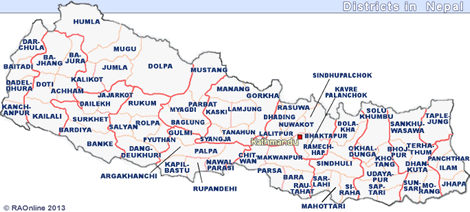|
Nepal's
Civil War: Analysis
|
|
Nepal's
New Alliance: The Mainstream Parties and the Maoists
|
 |
November
2005, International Crisis Group
Nepal's
mainstream parties and Maoists have reached agreement on a basic alliance
against the monarchy. That they were talking was not new: all sides have
kept in contact throughout the ten-year-old conflict. But this time they
have developed a serious agenda which offers the framework of a peace deal.
Their dialogue had India's tacit backing and the deal was finalised at
meetings in New Delhi.
The
agreement reflects some important achievements: the Maoists have formally
committed themselves to joining a multiparty system and the mainstream
parties have signed up to a process of constitutional change. Each side
has recognised past mistakes and vowed not to repeat them. But many issues
present challenges which have only been deferred. The Maoists reject the
parties' call to restore the last parliament and the parties have not accepted
the rebels' republican agenda. Questions of disarmament, monitoring and
future talks facilitation have been brushed over lightly. And it is not
clear if the new alliance will hold out an olive branch to the king or
try to force him into submission.
The
palace, which runs an embattled government, had tried to conceal its unease
as the talks went on but ministers have now gone on the offensive against
the new alliance. Conservative Nepali commentators and U.S. diplomats had
warned repeatedly of consequences if the parties did a deal with the Maoists.
Some critics hoped that the talks would fall apart or be derailed, but
the twelve-point November agreement has dramatically - though not yet irreversibly
- changed political realities.
Why
have the parties and Maoists done a deal? They have differing political
imperatives, and they have not changed their long-term goals, but there
are some grounds for compromise and both have realised that their own strength
is not enough to be decisive. The discussions have identified a possible
structure for peace talks - progressing via interim arrangements to a constitutional
assembly and disarmament - but each issue raises its own problems.
The
mechanics of dialogue are also far from straightforward. Although all sides
had previously kept channels of communication open, formal talks bring
risks. This engagement has taken place more comfortably thanks to India's
tacit endorsement. However, the negotiators lack the safety net of international
legitimacy and open facilitation. The Maoists are prepared and have a clear
strategy while the parties are still working out joint positions. Each
side has been happy to publicise certain details but the text of the November
agreement is thin and meetings have necessarily been secretive. The Indians
have played their cards close to their chest and left even close allies
guessing about their intentions.
The
parties' willingness to deal with the rebels has raised the stakes for
all players in the conflict. It has also brought new risks. This is only
a bilateral process; other crucial players - notably the palace - are excluded.
The parties are neither fully united nor well prepared and may concede
too much too easily as bargaining progresses, while the Maoists retain
their arms and could revert to a military approach at any time or could
use talks and a loose alliance to build a stronger urban base and squeeze
the mainstream parties in their last bastion. The November deal could prompt
a violent backlash if the palace feels threatened.
Nevertheless,
the alliance presents new opportunities:
 the
Maoists are acting under genuine imperatives and constraints and they are
willing to offer significant concessions; the
Maoists are acting under genuine imperatives and constraints and they are
willing to offer significant concessions;
 this
is a chance to bring the Maoists into the mainstream while they are still
united and can bring their armed cadres with them; the dialogue has already
led to a commitment in principle to disarm; this
is a chance to bring the Maoists into the mainstream while they are still
united and can bring their armed cadres with them; the dialogue has already
led to a commitment in principle to disarm;
 this
could be the best way of addressing broadly acceptable parts of the Maoist
agenda without giving way on everything; and this
could be the best way of addressing broadly acceptable parts of the Maoist
agenda without giving way on everything; and
 if
managed carefully, the process could strengthen democracy and help address
weaknesses in the 1990 multiparty constitution and the parties that have
embodied it. if
managed carefully, the process could strengthen democracy and help address
weaknesses in the 1990 multiparty constitution and the parties that have
embodied it.
The
ultimate outcome of the talks process cannot be predicted but the loose
party-Maoist alliance has created a new dynamic. In their first high-level
face-to-face meeting, party leaders and the Maoists have forged a basic
plan for joint action against the monarchy. In the weeks to come this plan
will take more concrete shape, and discussions will move to a second stage.
A
range of factors will then affect the approaches of both sides. Internal
tensions and calculations of personal advantage may be particularly debilitating
for the mainstream parties. As always, both sides will be watching other
domestic and international forces and adjusting course accordingly. The
king, keen to bolster his own power, still has cards to play. The talks
may not in themselves lead to a new peace process but they offer the best
hope of breaking Kathmandu's political impasse.
International
Crisis Group
Kathmandu/Brussels,
28 November 2005


|



